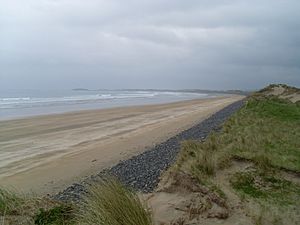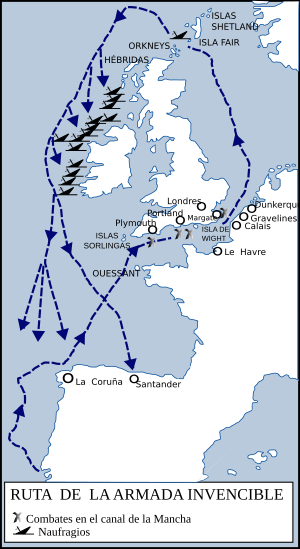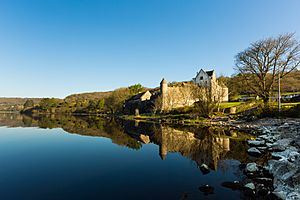Francisco de Cuellar facts for kids
Quick facts for kids
Captain
Francisco de Cuéllar
|
|
|---|---|
| Personal details | |
| Born | 1562 Valladolid, Spain |
| Died | After 1606 |
| Military service | |
| Allegiance | |
| Branch/service | Spanish Navy |
| Years of service | 1581-1606 |
| Rank | |
| Battles/wars | War of the Portuguese Succession Anglo-Spanish War • Spanish Armada |
Francisco de Cuéllar (born in Valladolid, Spain, around 1562) was a brave Spanish sea captain. In 1588, he sailed with the famous Spanish Armada. His ship was wrecked off the coast of Ireland, and he had an amazing adventure trying to survive and escape. He later wrote down his incredible story.
Contents
Early Life and Military Service
Francisco de Cuéllar was likely born in Valladolid, Spain, in 1562. His family name, Cuéllar, comes from a village in the Segovia province.
Before joining the Armada, Cuéllar was a soldier.
- He helped the Spanish army take over Portugal in 1581.
- He sailed to the Strait of Magellan in South America.
- He helped remove French settlers from Paraíba, Brazil.
- He also served under a famous Spanish leader, the Marquis of Santa Cruz, in the Azores islands.
The Spanish Armada Adventure

In 1588, Cuéllar was a captain on the San Pedro ship. This ship was part of the powerful Spanish Armada, a huge fleet sent to invade England. During a big storm in the North Sea, his ship left its position to make repairs. Because of this, Cuéllar was accused of not following orders. He was moved to another ship, the San Juan de Sicilia, and faced serious punishment.
Luckily, his punishment was not carried out. He stayed on the San Juan de Sicilia. Many ships of the Armada were lost in terrible storms as they tried to sail back to Spain. The San Juan de Sicilia and two other ships ended up off the coast of County Sligo, Ireland.
After five days, the strong winds pushed all three ships onto the beach. They broke apart, and out of 1,000 men on board, only 300 survived.
Surviving the Shipwreck
When the ships broke, many people drowned. Local people on the shore attacked and robbed the survivors. Cuéllar held onto a piece of wood and floated to shore without being seen. He hid among some tall plants. He was very weak. Another survivor joined him, but this man soon died.
Cuéllar kept losing and regaining consciousness. At one point, two armed men found him and the dead survivor. They covered them with plants before going to loot the beach. Later, Cuéllar saw 200 horsemen riding across the sand.
When he finally crawled out, he saw 800 dead bodies on the beach. He moved towards a small, burned church called the Abbey of Staad. There, he saw twelve of his countrymen who had been hanged by English soldiers. A local woman warned him to stay off the main road. He then met two Spanish soldiers who told him that English soldiers had killed 100 captured survivors.
The Spaniards saw 400 more bodies on another beach. When they stopped to bury two officers, four locals confronted them. Another local told them to leave and pointed them towards his village. They walked barefoot in the cold through a wood. There, two young men attacked Cuéllar, stabbing his leg. An old man stopped the fight.
Cuéllar was robbed of his clothes, a gold chain, and gold coins. The young woman with the group made sure his clothes were returned. She took a small locket from him, which she wore around her neck. A boy then came to treat his wounds with a special paste and brought him milk, butter, and bread.
Cuéllar listened to the boy's warning not to go into the village. He limped past it alone, eating berries and watercress to survive. He was attacked again by a group of men who beat him and took his clothes. He covered himself with a skirt made of woven ferns. He found a deserted place by a lake and was surprised to find three other Spaniards there. They stayed for a while, then met a young man who spoke Latin. This young man directed them to the land of Sir Brian O'Rourke in County Leitrim.
Life in O'Rourke's Country
In O'Rourke's country, they found more safety. They reached a village where 70 other Spaniards were being helped. Cuéllar, wearing old, dirty clothes, traveled north with a group to meet a Spanish ship. But the ship had already left.
He returned to O'Rourke's country. The lord's wife was very kind to him. She was interested in his ability to tell fortunes.
- "One day, we were sitting in the sun with her friends and family. They asked me about Spain and other places. Then they asked me to look at their hands and tell them their fortunes. I was thankful it wasn't worse! I started looking at their hands and making up all sorts of silly things. They loved it so much that I became their favorite Spaniard. Day and night, men and women kept asking me to tell their fortunes. I was so busy that I had to ask my master for permission to leave his castle."
Cuéllar noticed that the people lived in a wild way, but they were friendly and followed Christian customs. They often raided other groups and were bothered by English soldiers. He believed that without their kindness, he and his friends would not have survived. He wrote, "These people liked us because they knew we were against their enemies, the English. If it weren't for those who protected us, none of us would have lived." He also said, "In this country, there is no justice or law, and everyone does what they like."
The Siege at Rosclogher
In November 1588, Cuéllar and eight other Spaniards went to the land of the MacClancy, another Irish lord. They stayed at one of his castles, probably Rosclogher, near Loch Melvin. News arrived that the English had sent 1,700 soldiers to MacClancy's area. The lord decided to hide in the mountains, but the Spaniards chose to defend the castle.
They had 18 firearms and thought the castle was safe because it was in a boggy area. This meant the English could not use their cannons. The English arrived under the command of Richard Bingham's brother. The siege lasted 17 days. The English could not cross the bog. A big storm with heavy snow forced them to leave.
MacClancy returned and gave gifts to the defenders. He even offered Cuéllar his sister's hand in marriage, but Cuéllar said no. Against the chieftain's advice, the Spaniards secretly left ten days before Christmas. They headed north to find the bishop of Derry, Redmond O'Gallagher. The bishop was helping twelve other Spaniards and planned to help them cross to Scotland.
Escape to Safety
After six days, Cuéllar and 17 others sailed to Scotland in a small boat called a pinnace. Two days later, they reached the Hebrides islands, then landed on the Scottish mainland. Cuéllar had heard that the Scottish king protected all Spaniards and helped them return to Spain. However, after six months in Scotland, he realized that the King of Scotland had little power and had to follow orders from Queen Elizabeth I of England.
Eventually, with help from the Duke of Parma, Cuéllar got a passage to Flanders in the Low Countries. But the Dutch were waiting on the coast to capture Armada survivors. Cuéllar's ship was caught in a fight, and many survivors drowned or were killed. Once again, he found himself clinging to floating wreckage. He reached shore in Flanders and walked into the city of Dunkirk wearing only his shirt. He wrote down his amazing story and later returned to Spain.
Sadly, Brian O'Rourke was hanged in London in 1590 for helping the Armada survivors. MacClancy was captured and beheaded in 1590.
Later Life
After his incredible escape, Francisco de Cuéllar continued his military career. He served in the Spanish army in various battles and sieges across Europe between 1589 and 1598. He also served in Italy.
In 1601, he was asked to return to America. He became a captain on a galleon heading to the Windward Islands, sailing in 1602. This was his last military service. He lived in Madrid from 1603 to 1606, hoping for new missions in America.
We don't know when or how Francisco de Cuéllar died, or if he had any children.
See also
 In Spanish: Francisco de Cuéllar para niños
In Spanish: Francisco de Cuéllar para niños




